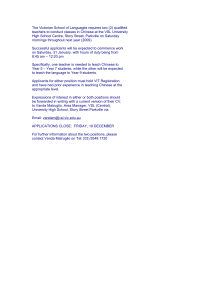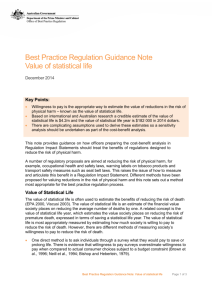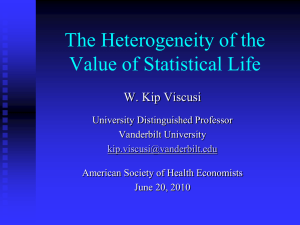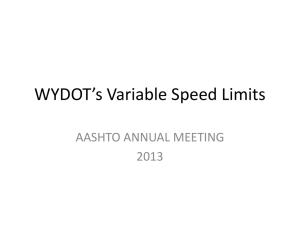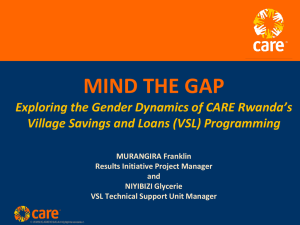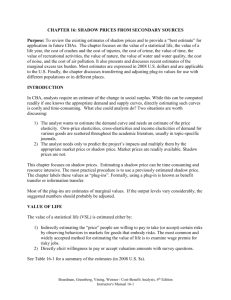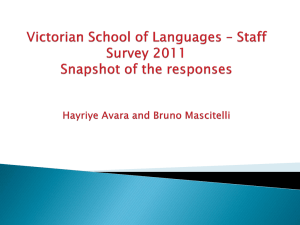DISCUSSION PAPER Adjusting the Value of a Statistical Life for
advertisement
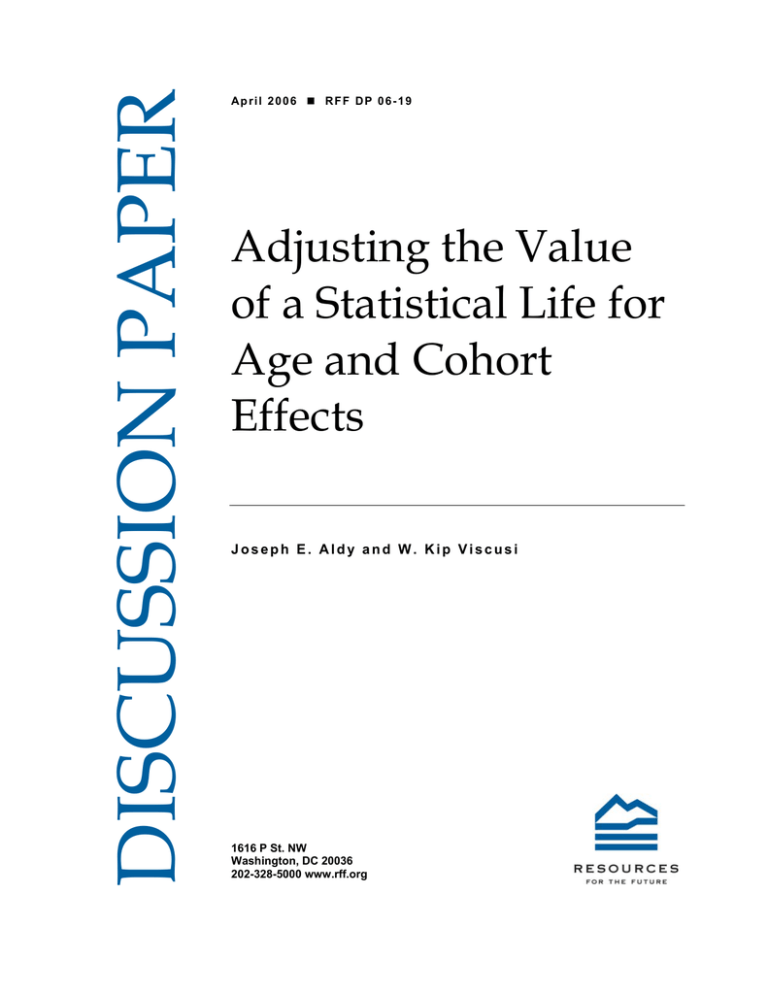
DISCUSSION PAPER Ap r i l 2 0 0 6 R F F D P 0 6 - 1 9 Adjusting the Value of a Statistical Life for Age and Cohort Effects Joseph E. Aldy and W. Kip Viscusi 1616 P St. NW Washington, DC 20036 202-328-5000 www.rff.org Adjusting the Value of a Statistical Life for Age and Cohort Effects Joseph E. Aldy and W. Kip Viscusi Abstract To resolve the theoretical ambiguity in the effect of age on the value of statistical life (VSL), this article uses a novel, age-dependent fatal risk measure to estimate age-specific hedonic wage regressions. VSL exhibits an inverted-U shaped relationship with age. In the year 2000 cross-section, workers’ VSL rises from $3.2 million (ages 18–24), to $9.9 million (35–44), and declines to $3.8 million (55–62). Controlling for birth-year cohort effects in a minimum distance estimator yields a peak VSL of $7.8 million at age 46 and flattens the VSL-age relationship. The value of statistical life-year also follows an inverted-U shape with age. Key Words: value of statistical life, job risks, hedonic wage regression, VSLY JEL Classification Numbers: J17, I12 © 2006 Resources for the Future. All rights reserved. No portion of this paper may be reproduced without permission of the authors. Discussion papers are research materials circulated by their authors for purposes of information and discussion. They have not necessarily undergone formal peer review. Contents I. Wage-Risk Tradeoffs over the Life Cycle ......................................................................... 4 II. Hedonic Wage Methods and Results................................................................................ 7 A. Data ................................................................................................................................ 7 B. Hedonic Wage Regression Framework.......................................................................... 8 C. Estimated Age Group VSLs......................................................................................... 10 D. Minimum Distance Estimator and Cohort Effects....................................................... 11 IV. Implications for the Value of a Statistical Life-Year .................................................. 14 V. Conclusion......................................................................................................................... 15 References.............................................................................................................................. 17 Tables and Figures................................................................................................................ 19 Resources for the Future Aldy and Viscusi Adjusting the Value of a Statistical Life for Age and Cohort Effects Joseph E. Aldy and W. Kip Viscusi∗ A strident controversy with respect to the value of life has been whether the benefit of reducing risks to the old are less than for younger age groups. In particular, should there be a socalled “senior discount” when assessing the value of reduced risks to life? This question has drawn the attention of policymakers in a number of countries. In 2000, Canada employed a value of statistical life (VSL) for the over-65 population that is 25 percent lower than the VSL for the under-65 population (Hara and Associates 2000). In 2001, the European Commission recommended that member countries use a VSL that declines with age (European Commission 2001). In 2003, the U.S. Environmental Protection Agency (EPA), which has traditionally employed a constant value of a statistical life to monetize mortality risk reductions irrespective of the age of the affected population, conducted analyses of the Clear Skies initiative that included a “senior discount.”1 This effort to apply such a discount in its Clear Skies initiative analyses generated a political firestorm and ultimately led to abandonment of any age adjustments in benefit values assigned by the Agency.2 Intuitively one might expect that older individuals may value reducing risks to their lives less because they have shorter remaining life expectancy. The commodity they are buying through risk reduction efforts is less than for younger people. Carrying this logic to its extreme, ∗ Aldy: Resources for the Future, 1616 P Street NW, Washington, DC 20036 (email: aldy@rff.org); Viscusi: Harvard Law School, 1575 Massachusetts Avenue, Cambridge, MA 02138 (e-mail: kip@law.harvard.edu). Aldy’s research is supported by the U.S. Environmental Protection Agency STAR Fellowship program and the Switzer Environmental Fellowship program. Viscusi’s research is supported by the Harvard Olin Center for Law, Economics, and Business. The authors express gratitude to the U.S. Bureau of Labor Statistics for permission to use the CFOI fatality data. Neither the BLS nor any other government agency bears any responsibility for the risk measures calculated or the results in this paper. Antoine Bommier, Gardner Brown, David Cutler, Bryan Graham, Caroline Hoxby, Seamus Smyth, and James Ziliak and seminar participants at Harvard University and the AERE Summer Workshop provided constructive comments. 1 In the “senior discount” analyses, the EPA provided two alternatives to account for age. One approach was based on a standard value of a statistical life-year approach that explicitly accounts for life expectancy. The second approach assumed that individuals over age 70 had a value of statistical life equal to 63 percent of the value for those under 70. 2 For a sense of the political reaction and EPA’s decision to discontinue the use of an age-based value of statistical life, refer to “EPA Drops Age-Based Cost Studies,” New York Times, May 8, 2003; “EPA to Stop ‘Death Discount’ to Value New Regulations,” Wall Street Journal, May 8, 2003; and “Under Fire, EPA Drops the ‘Senior Death Discount,’” Washington Post, May 13, 2003. 1 Resources for the Future Aldy and Viscusi the VSL would peak at birth and decline steadily thereafter. For models in which consumption is constant over the life cycle, Jones-Lee (1989) showed that the VSL should decrease with age. Whether consumption will in fact be constant over time depends critically on the presence of perfect capital and insurance markets. Numerous theoretical studies have shown that the age variation in VSL becomes more complex once changes in consumption over time are introduced into the analysis. Changes in consumption levels and wealth over the life cycle influence risk-money tradeoffs in a complex manner. Johansson (2002) concluded that the theoretical relationship between the VSL and age is ambiguous and could be positive, negative, or zero. Often theoretical studies, however, have imposed additional structure on the analysis, implying that there is either an inverted U-shaped relationship between the value of statistical life and age or that VSL decreases with age. The simulations by Shepard and Zeckhauser (1984) show a steadily declining value of life if there are perfect annuity and insurance markets, and an inverted-U VSL-age relationship in an economy with no borrowing or insurance, as do Johansson (1996) and Ehrlich and Yin (2004). Rosen (1988), Arthur (1981), and Cropper and Sussman (1988) also present simulation results with VSL decreasing with age. Empirical evidence based on labor market data may be instructive in resolving the theoretical ambiguity in the VSL-age relationship. Viscusi and Aldy (2003) review eight studies of labor markets in Canada, India, Switzerland, and the United States that included an agemortality risk interaction term in their hedonic wage analysis. Five studies estimated statistically significant coefficient estimates on the age-risk interaction and all find a negative effect indicating that older workers value risks to their lives less.3 These results imply implausibly low VSL levels with negative VSL amounts beginning at ages ranging from 42 to 60. The failure of labor market evidence to resolve the age variation issue may stem in part from data limitations. All these labor market studies use fatality risk data that are based on industry averages rather than age-specific values, causing potential biases, where the magnitude of the bias varies with age. If, for example, average industry fatality risks for workers of all ages overstate the risks faced by older workers, the estimated implied VSL amounts for older workers will understate the wage-risk tradeoffs that are actually being made. 3 These studies are reviewed in Section 8 of Viscusi and Aldy (2003). In contrast, a recent study by Smith et al. (2004) has found that the value of statistical life is increasing with age and risk aversion for workers 51–65 years of age. 2 Resources for the Future Aldy and Viscusi All previous papers assessing how the compensating differential for job mortality risk varies with age have employed cross-sectional survey data. By using a single cross-section, such approaches confound the cohort-specific influence and age-specific effects on the estimated compensating differential. The cohort influence based on the year of birth should have an unambiguous effect on VSL. Lifetime incomes are rising over time, and the VSL has a positive income elasticity of 0.5 to 0.6.4 Because older workers belong to an earlier cohort with lower lifetime incomes, they will tend to be willing to pay less for a given risk reduction, implying a lower VSL. The pure age effect is less clear-cut. As a worker ages, there are fewer years of remaining life expectancy, implying lower benefits for a given risk reduction, which should reduce the worker’s willingness to pay to reduce risk. This effect is unambiguous if capital markets are perfect. In a world with imperfect capital markets, however, lower income younger workers will not be able to borrow against higher future expected earnings. This will depress their VSLs at young ages until borrowing constraints become less stringent, resulting in an agerelated VSL trajectory similar to the inverted-U shape of life-cycle consumption patterns. Extending the traditional analysis to a pooled series of cross-sections will enable us to distinguish age effects from cohort effects. Two separate, but both policy-relevant, questions can then be considered: (1) How does the value of life vary with age across the population? and (2) How do differences in cohorts influence this relationship? This article extends the previous literature in several respects. Because our focus is on risky labor market decisions, we make job risk decisions a choice variable in a life-cycle consumption model in Section I, deriving an expression for VSL in this context. In Section II, we present empirical estimates how the VSL varies over the life cycle through conventional hedonic wage equations and a minimum distance estimator. These results reflect two innovations to this literature: (1) we employ age-specific job mortality and nonfatal injury risks in our hedonic wage analyses; and, (2) we estimate how the VSL changes over the life cycle by pooling eight years of cross-sectional data and by using a minimum distance estimator that controls for cohort effects based on year of birth. In these empirical approaches, the VSL rises and then falls across the population and over the life cycle. In the cross-sectional analysis, the VSL peaks at age 39 and subsequently declines so that the VSL for workers in their early 60s have values of about $2 million. In the cohort-adjusted analysis, the VSL peaks at age 46, and experiences a more modest 4 See Viscusi and Aldy (2003) for a meta-analysis of the VSL income elasticity value. 3 Resources for the Future Aldy and Viscusi decline to about $5 million by age 62.5 In Section III, we calculate age-specific values of statistical life-years (VSLY) from our age-VSL profiles and find that VSLYs also take an inverted-U shape with a peak at an older age than the VSLs. In the cross-sectional analysis, the VSLY peaks at $375,000 at age 45 and subsequently declines to about $150,000 in workers’ early 60s. In the cohort-adjusted analysis, the VSLY peaks at $401,000 at age 54, and experiences a more modest decline to about $350,000 by age 62. Section IV concludes the paper. I. Wage-Risk Tradeoffs over the Life Cycle The standard approach in the life-cycle VSL literature employs a time-separable utility function in one consumption good, integrated over the life-cycle subject to a discount function and a survival function, as in Shepard and Zeckhauser (1984), Rosen (1988), Johansson (1996, 2002), and Johannesson et al. (1997). The only choice variable is the level of consumption over time. In these analyses, the value of statistical life is given by a representative agent’s expected present value of consumer surplus conditional on having achieved a given age. For example, Shepard and Zeckhauser represent this as the ratio of expected remaining lifetime utility to the marginal utility of consumption. To motivate our empirical work, we provide a model of wage-risk tradeoffs in a lifecycle setting. We modify and extend the standard life-cycle approach to explicitly account for the choice of job fatality risk on the survival function and the worker’s wage. Since a change in job fatality risk affects both the worker’s wage and life expectancy, our approach provides an alternative illustration of the VSL varies over the life cycle by characterizing the wage-risk tradeoff given the impacts of both on future consumption. By incorporating a compensating differential framework in our model, we can demonstrate how the wage-risk trade-off varies over the life cycle, which is what we will estimate in our empirical work presented below. Our simple model indicates variations in VSL, but the linkage is ambiguous. This lifecycle model can illustrate the influences – especially the life-cycle variation in consumption – that can generate an inverted U-shaped relationship between VSL and age. The worker’s problem can be characterized by maximizing discounted expected remaining lifetime utility: ∞ (1) 5 All max EU (τ ) = ∫ u[c(t )]σ [t ;τ , p (t )]e −rt dt , p ,c τ VSL estimates are presented in year 2000 dollars in this paper. 4 Resources for the Future Aldy and Viscusi subject to (2a) k&(t ) = rk (t ) + w[t , p(t )] − c(t ) + f (t ) , (2b) k (t ) ≥ 0 , and lim k (t )e − rt = 0 , (2c) t →∞ where p represents the probability of dying on the job, u (c) represents the utility of consumption, c , and u ′(c) ≥ 0 , u ′′(c) ≤ 0 , k represents assets, w represents labor income, e − rt represents the discount function, σ [t ; τ , p(t )] represents the survival function, i.e., the probability of surviving to age t, given that the individual has reached age τ ,6 r represents the return on assets, and f (t ) represents the net amount received through an actuarially fair annuity represented by the condition: ∞ ∫e − rt σ [t ;0, p(t )] f (t )dt = 0 .7 0 The worker’s expected utility is represented in (1) as the sum of period utilities weighted by a discount factor and the probability that the worker will survive to that period conditional on the worker’s current age. The worker maximizes this expected utility expression subject to the constraints: (2a) represents the dynamic budget constraint, and it allows for the worker’s assets 6 This expression of the survival function follows Johansson (1996): 7 To σ [t ; τ , p (t )] = σ [t ; p(t )] / σ (τ ) . simplify notation, we have followed Shepard and Zeckhauser and assumed that the rate of time preference in the discount function is equal to the rate of return on assets, and that this rate is time-invariant. Allowing for the rate of time preference to differ from the return on assets would not substantively influence the primary conclusion of this analysis that the age-VSL relationship is ambiguous. 5 Resources for the Future Aldy and Viscusi to change over time based on capital income rk (t ) , labor income w[t , p(t )] , consumption c(t ) , and net annuity receipts f (t ) ; (2b) provides a no debt condition; and (2c) is the standard no Ponzi game condition. The actuarially fair annuity envisioned here is similar to that in Shepard and Zeckhauser’s (1984) perfect markets case, and the annuity allows for the worker to borrow against human capital during early years of life to provide for consumption smoothing. The present value Hamiltonian, conditional on having lived to age τ, is given by: (3) H (t ) = u[c(t )]σ [t ; τ , p(t )]e − rt + λ (t )[rk (t ) + w[t , p(t )] − c(t ) + f (t )] where λ (t ) represents the present value costate variable. The first-order conditions for the Hamiltonian are: (4) ∂H = u c σe − rt − λ = 0 ,8 ∂c (5) ∂H = uσ p e − rt + λw p = 0 , ∂p and (6) − ∂H = λ& → λ& = −rλ . ∂k To see more generally how the value of a statistical life varies with age, we rearrange (5), differentiate with respect to time, where time derivatives are denoted by a dot over the variables in question, and substitute into (6), yielding: (7) w& p wp = u& σ& p + u σp The percentage change over time in the compensating differential for job fatality risk is equal to the percentage change over time in utility and the percentage change over time in the change in the survival function with respect to job fatality risk.9 This expression holds irrespective of the assumption of actuarially fair annuity markets, although the assumption regarding these markets clearly influences the change in utility over the life cycle. The sign on 8 This is essentially identical to equation 12 of Shepard and Zeckhauser (1984). Note that the survival function, σ [t ; τ , p (t )] , and the discount function, e through their influence on the optimal consumption and job fatality risk paths. − rt 9 6 , implicitly enter equation (7) Resources for the Future Aldy and Viscusi equation (7) is ambiguous without imposing restrictions on the survival function and specifying the assumptions regarding annuity markets. This ambiguity is consistent with the life-cycle model provided by Johansson (2002) and the simulation results based on the life-cycle model in Shepard and Zeckhauser (1984). This theoretical ambiguity motivates our interest in resolving empirically how the value of a statistical life varies over the life cycle. II. Hedonic Wage Methods and Results To assess empirically the age-VSL relationship, we have expanded the standard hedonic wage framework in two ways. First, using our new and more refined age-specific job-related mortality and injury data, we estimated hedonic wage regressions that allow for the compensating differential for these risks to vary among five age groups. These results indicate how the VSL varies with age across the population. Second, we develop a minimum distance estimator that incorporates age-specific hedonic wage regressions in the first stage and controls for cohort effects in the second stage. This analysis, based on eight years of pooled crosssections, indicates how the value of life varies with an individual’s age. A. Data To characterize the fatality risks faced by workers of different ages more precisely than is possible using average risk values by industry, we constructed a novel risk measure conditional upon age and the worker’s industry rather than using an industry basis alone, which is the norm for all previous studies of age variations in workers’ VSL. The source of the fatality measures is the Bureau of Labor Statistics (BLS) Census of Fatal Occupational Injuries (CFOI), for the 19922000 period. We structured the mortality risk cells by 2-digit SIC industries and these six age groups specified in the CFOI data: 16–19, 20–24, 25–34, 35–44, 45–54, and 55–64. To construct the denominator for the mortality risk variable, we used the 1992–2000 Current Population Survey Merged Outgoing Rotation Group files to estimate worker populations for each cell in the mortality data. The annual mortality risk measures are averaged to minimize any potential distortions associated with catastrophic mortality incidents in any one year and to have a better measure of the underlying risks for industry-age groups with infrequent deaths. Our injury risk measure, the probability of a lost-workday injury, also varies by age, and we constructed it in an identical manner for each 2-digit industry and for each of the age groups listed above. While 7 Resources for the Future Aldy and Viscusi injury risk decreases with age across most industries, mortality risk increases monotonically with age in all industries, except for in mining.10 We have matched these constructed mortality risk and injury risk measures by age and industry with data on adult workers in the Current Population Survey Merged Outgoing Rotation Group data files for 1993–2000. We employed a number of screens in constructing our sample for analysis. The sample excludes agricultural workers and members of the armed forces. We have excluded workers younger than 18 and older than 62, those with less than a 9th grade education, workers with an effective hourly labor income less than the minimum wage, and less than full-time workers, which we defined as those working at least 35 hours per week. B. Hedonic Wage Regression Framework The standard hedonic wage model estimates the locus of tangencies between the market offer curve and workers’ highest constant expected utility loci. The age variation in the wagemortality risk tradeoff simultaneously reflects age-related differences in preferences as well as age-related differences in the market offer curve. If older workers are more likely to be seriously injured than are younger workers because of age-related differences in safety-related productivity, then the market offer curve will reflect that, given that age is a readily monitorable attribute. Because workers’ constant expected utility loci and firms’ offer curves each may vary with age, there is no single hedonic market equilibrium. Rather, workers of different ages will settle into distinct market equilibria as workers of different ages select points along the market opportunities locus that is pertinent to their age group.11 Conventional hedonic wage analyses of job risks specify the natural logarithm of the hourly wage or some comparable income measure as a function of worker and job characteristics, mortality risk, and, in more comprehensive specifications, injury risk and a measure of workers’ compensation. Our base specification takes the following form: (8) ln(wi ) = α + H i′β + γ 1 pi + γ 2 qi + γ 3 q iWC i + ε i , where 10 Refer to Aldy and Viscusi (2004) for more details about the construction of this age-specific job mortality risk measure. 11 This analysis generalizes the hedonic model analysis for heterogeneous worker groups using the model developed for an evaluation of smokers and nonsmokers by Viscusi and Hersch (2001). Their worker groups differ in their safety-related productivity and in their attitudes toward risk. 8 Resources for the Future Aldy and Viscusi wi is the worker i’s hourly after-tax wage rate, H is a vector of personal characteristic variables for worker i, pi is the fatality risk associated with worker i’s job, qi is the nonfatal injury risk associated with worker i’s job, WCi is worker i’s compensation replacement rate for a job injury, and ε i is the random error reflecting unmeasured factors influencing worker i’s wage rate. We calculated the workers’ compensation replacement rate on an individual worker basis taking into account state differences in benefits and the favorable tax status of these benefits. We use the benefit formulas for temporary total disability, which comprise about three-fourths of all claims, and have formulas similar to those for permanent partial disability.12 The terms α, β, γ1, γ2, and γ3 represent parameters to be estimated. All wage regression specifications used in this paper include the following controls: demographic indicator variables (race and ethnicity, gender of head of household, marital status, union membership, public sector employment, and resident of urban area); educational attainment; indicator variables for one-digit occupation and region of residence; and job mortality risk, job nonfatal injury risk, and expected workers’ compensation replacement rate.13 The estimated regression then yields a measure of the average value of a statistical life for the sample: (9) VSL = γˆ1 * w * 2,000 * 100,000 . This equation normalizes the VSL to an annual basis by the assumption of a 2,000-hour work-year and by accounting for the units of the mortality risk variable. As a preliminary check on our age-industry risk variables, we estimated equation (8) with the 1997 CPS MORG and compared this with the results for industry risk variables merged with the 1997 CPS MORG 12 The procedures for calculating the workers’ compensation benefit variable are discussed in more detail in Viscusi (2004), which also provides supporting references. 13 The workers’ compensation expected replacement rate represents the interaction of a worker’s injury rate and that worker’s estimated workers’ compensation wage replacement rate based on the worker’s wage, state of residence, state benefit formulas, and estimated state and federal tax rates. Given the endogeneity of the wage, we have also estimated instrumental variables regressions. IV estimation does not qualitatively influence determinations of coefficient magnitudes or statistical significance for the mortality risk variable of interest in this study. Refer to Aldy and Viscusi (2004) for additional details. 9 Resources for the Future Aldy and Viscusi dataset presented in Viscusi (2004). We estimated a mean VSL of $4.5 million (1997$), which is virtually indistinguishable from the Viscusi (2004) estimate of $4.7 million, and both studies fall within the range of VSLs from hedonic wage regression studies of the U.S. labor market reported in Viscusi and Aldy (2003).14 C. Estimated Age Group VSLs As an initial assessment of how the value of life varies with age across the population, we modified (8) so that the estimated compensating differentials can vary by age. We interacted five age group indicator variables – for age groups 18–24, 25–34, 35–44, 45–54, and 55–62 – with the various risk measures, and included the first four age group indicator variables in the specification: 4 5 5 5 j =1 j =1 j =1 j =1 (8a) ln(wi ) = α + H i′β + ∑ δ j age j + ∑ γ 1 j age j p i + ∑ γ 2 j age j q i + ∑ γ 3 j age j q iWC i + ε i , where age j are the indicator variables for the five age groups and δ j are parameters to be estimated. We estimated this modified specification with eight annual CPS MORG samples from 1993–2000 and our industry by age job mortality risk and nonfatal injury risk data.15 As distinct cross-section regressions, these specifications cannot discern age effects from cohort effects. They do, however, reveal how much an individual currently in one age group at a point in time is willing to pay for a given risk reduction vis-à-vis how much a different individual currently in another age group is willing to pay for such a risk reduction. Table 1 presents the age-group specific results for this specification. We report two sets of standard errors: White heteroskedasticity-adjusted standard errors and robust and clustered standard errors that account for within-group correlations due to the assignment of the same job risk level to workers in an age-industry cell in each year.16 The eight annual cross-section 14 In our analysis with the 1997 CPS MORG, the mortality risk coefficient estimate is 0.0019 with a robust standard error of 0.00021. 15 Note that we used averages of the lagged risk measures in these analyses. For example, the 1995 regression included risk measures averaged over 1992-1994 while the 2000 regression included risk measures averaged over 1992–1999. 16 Refer to Hersch (1998) and Viscusi and Hersch (2001) as examples of papers in this literature that account for this type of correlation. 10 Resources for the Future Aldy and Viscusi regressions reveal similar patterns of the VSL with respect to age: an inverted-U shape with the VSL peaking for the 35–44 age group in six of the eight years. As an illustration, consider the results for the year 2000 cross-section. The coefficient estimate on the 18–24 age group mortality risk variable is 0.0021, and it increases substantially to 0.0039 for the 25–34 age group. The mortality risk coefficient then declines with age: 0.0036 for the 35–44 age group, 0.0028 for the 45–54 age group, and 0.0014 for the 55–62 age group. The five age-group-specific job mortality risk coefficient estimates are individually statistically significant at the 1 percent or 5 percent level. The estimated VSLs for each age group depend on these coefficient estimates as well as age-group-specific average wages, which follow an inverted-U shape over the life cycle. The 35– 44 age group has the largest VSL of $9.85 million, more than triple the 18–24 VSL of $3.16 million and nearly triple that of the 55–62 VSL of $3.77 million.17 To show how these differences in magnitudes are often statistically significant, we focus on the results for the year 2000 cross-section, which we report again at the top of Table 2. We conducted a series of pairwise Wald tests on the estimated VSLs, and the table presents the Fstatistics associated with these tests. The first row of these tests shows that the 18–24 VSL of $3.16 million is statistically different from the VSL estimates for the next three age groups, but does not differ significantly from the 55–62 VSL of $3.77 million. The last column, corresponding to the 55–62 age group, shows that the estimated 55–62 VSL differs significantly from the VSL estimates for the 25–34 age group, the 35–44 age group, and the 45–54 age group. These results indicate that the VSL takes an inverted-U with respect to age across a population. The VSL pattern is relatively flat in the middle age groups as there is no statistically significant difference among the age 25–34, 35–44, and 45–54 categories for the 2000 cross-section. D. Minimum Distance Estimator and Cohort Effects We have extended this age-specific regression analysis in subsection C through a twostage minimum distance estimator using VSL estimates for each year rather than age bands. This approach allows us to infer information about the VSL with respect to age based on a larger number of regressions based on more narrowly defined age bands for each year. While these individual regressions will provide less precise estimates of the compensating differential for risk 17 Refer to Jones-Lee et al. (1985) for an example of a stated willingness to pay for safety study that also finds an inverted-U shaped VSL-age relationship. 11 Resources for the Future Aldy and Viscusi than broader age groups, it will then be possible to estimate VSLs as a function of age if agespecific VSLs follow a systematic pattern over the life cycle. In the first stage, we estimate age-specific hedonic wage regressions of the form expressed in equation 8 and use the mortality risk coefficient estimates to construct age-specific VSL. We estimated age-specific compensating differentials for 45 age levels from age 18 to 62 and eight cross-sections from 1993–2000, yielding 360 separate regressions. With the exception of the youngest and oldest birth-year cohorts, every cohort has eight observations in our constructed panel.18 We estimated the VSL using the mean real wage for that respective age and year. Based on these first stage regressions, we construct a panel of cohort-specific and agespecific VSL estimates. Each VSL estimate is assigned to a birth-year cohort. For example, the estimated VSL for a 40-year old in 1993 is assigned to the 1953 birth-year cohort; the estimated VSL for a 41-year old in 1994 is also assigned to the 1953 birth-year cohort, and so on. We followed this procedure for all 360 VSL estimates. In the second stage, we specify these VSLs by age. To characterize how the VSL estimates from the first stage, VSˆL , vary with age across a population, the second stage includes a polynomial in age, a(θ ) . To characterize how the VSL varies over the life cycle, we account for the differences across cohorts by including a vector of birth-year indicator variables, c , in addition to the age polynomial. We also employ Vˆ , the inverse of a diagonal matrix of the variance estimates of these VSLs, as a weight matrix based on Chamberlain’s (1984) analysis of the minimum distance estimator and the choice of the inverse of the variance-covariance matrix as the optimal weight matrix.19, 20 18 Refer to Deaton (1985) and Deaton and Paxson (1994) for the advantages of such a constructed panel based on birth-year cohorts. 19 Because of the potential small sample bias in the optimal minimum distance estimator, we also evaluated the equally weighted minimum distance estimator (Altonji and Segal 1996). To address concerns about the small sample bias, we have presented the results for the equally weighted minimum distance estimator in Figures 1 and 2. The choice of weight matrix has no qualitative impact on our conclusions. 20 We have employed a test of overidentifying restrictions to assess the appropriate order of the polynomial in age. If we assume that θ is a Kx1 vector, then a restricted parameter vector, α , which is Rx1 where R<K, can be estimated by some function, b(α ) . The following test statistic can then be used to evaluate the restrictions on the parameter vector: N [VSˆL − b(αˆ )]'Vˆ −1 [VSˆL − b(αˆ )] − N [VSˆL − a(θˆ)]'Vˆ −1 [VSˆL − a(θˆ)] ~ χ K2 − R . An analogous statistic was employed to evaluate the order of the age function in the cohort-based minimum distance estimator. 12 Resources for the Future Aldy and Viscusi For the cross-sectional analysis, the minimum distance estimator solves: (10) min[VSˆL − a(θ )]′[Vˆ ] −1 [VSˆL − a(θ )] . θ ∈Θ For the life-cycle (cohort-adjusted) analysis, the minimum distance estimator solves: (11) min [VSˆL − a (θ ) − c ′δ ]′[Vˆ ] −1 [VSˆL − a (θ ) − c ′δ ] . θ ∈Θ ,δ ∈∆ where θ and δ represent parameters to be estimated. We specified a(θ ) in a variety of analyses as a polynomial in age of order one to order eight. The solid curve in Figure 1 presents the fitted age-VSL functions based on a third-order polynomial in age specification (cross-section VSL), while the dashed line presents the relationship based on a third-order polynomial in age with birth-year cohort indicator variables (cohort-adjusted VSL).21 In the pooled cross-sections, the value of statistical life increases with age from age 18 with a VSL of $4.87 million through age 39, at which the VSL peaks at $8.27 million. The value of a statistical life then declines with age to a minimum of $1.67 million at the highest age in the sample, which is 62. The cohort-adjusted function, also yields a VSL that follows an inverted-U shape over the life cycle. It starts at $3.39 million at age 18, peaks at $7.79 million at age 46, and then declines to $5.09 million at age 62. Across the population and along the life cycle, the value of statistical life increases, peaks, and then decreases with age. While not presented, the birth-year indicator variables follow a general trend of increasing values with year of birth, consistent with the proposition that the value of life has increased with temporal increase in lifetime income. The cohort adjustment affects the age-related pattern of VSLs in several ways. The peak of the age-VSL curve is seven years later when accounting for date of birth. The high VSLs for younger age groups is due in part to their higher lifetime wealth, as their cross-section VSLs lie above those in the cohort-adjusted values. For older age groups the pattern is reversed. While there is a steep drop in VSL levels with age in the cross-section results, this decline is due in part to cohort effects. Accounting for cohort differences attributable to changes in lifetime income more than doubles the estimated VSLs for the older age groups and flattens their VSL trajectory. Finally, the counter-clockwise pivoting of the VSL function from the cross-sectional analysis to 21 Based on the specification test presented in footnote 17, we could not reject the hypothesis that a third-order age polynomial fit the data as well as higher-ordered polynomials. We could, however, reject the hypothesis that lowerordered polynomials fit the data as well as a third-order polynomial. 13 Resources for the Future Aldy and Viscusi the cohort-adjusted analysis also illustrates the importance of accounting for lifetime income, implicitly through the birth-year indicator variables, in estimating the age-VSL relationship over the life cycle. We also tested two economic propositions that are prominent in current policy applications of the value of life. First, many analyses assume that the VSL remains constant, irrespective of age.22 To assess this proposition, we employed our cohort-based minimum distance estimator and specified the age polynomial function as a constant. We then tested this restriction versus the more flexible, higher-ordered polynomials and we reject the hypothesis that the VSL is constant over the workers’ life cycle at the 1 percent level in comparison with all age polynomials of order two or higher. Second, other analyses have assumed that the value of a statistical life is always decreasing with age.23 To test this proposition, we specified the age polynomial function as linear, but such an approach yielded a negative coefficient estimate that clearly could not be distinguished from zero. The test of overidentifying restrictions rejected the linear specification in comparison to all higher-ordered polynomials. It should also be noted that all order two through order eight polynomials resulted in similar inverted U-shaped relationships between the value of a statistical life and age.24 IV. Implications for the Value of a Statistical Life-Year The preceding section illustrates the estimated age-VSL profile consistent with the theory model presented in Section I and with previous simulations published in the literature. The implicit assumptions underlying the value of a statistical life-year (VSLY) approach, which requires the value of life to be decreasing with age at all ages, are rejected by our data. In light of the common application of VSLYs in evaluations of medical interventions and government regulations, such as those promulgated by the U.S. Food and Drug Administration and the U.S. Environmental Protection Agency in their sensitivity analyses, we have estimated age-specific VSLYs based on our age-specific VSLs. 22 For example, most U.S. Environmental Protection Agency benefit-cost analyses, including September 2003 revisions to its assessment of the Clear Skies initiative, make this assumption. 23 For example, this is consistent with the European Commission’s proposed position and the life-year approach used by the U.S. Food and Drug Administration. 24 We also evaluated whether the higher VSLs for individuals in the 25-44 age range reflect major life-cycle events such as marriage or having children, and not variations in age, but find no evidence to support this notion. Refer to Aldy and Viscusi (2004) for more details. 14 Resources for the Future Aldy and Viscusi To construct values of statistical life-years, we have annuitized age-specific VSLs based on age-specific years of life expectancy L and an assumed discount rate r of 3 percent:25 (12) VSLY = rVSL . 1 − (1 + r ) − L Figure 2 presents these calculations for the cross-section and cohort-adjusted VSLs derived from the minimum distance estimator. The average VSLY is $296,000 for the crosssection and $302,000 for the cohort-adjusted estimates. VSLYs follow a similar inverted Ushaped relationship over the life cycle as depicted for VSL. The increase in VSLY is clearly expected for young workers because VSL is increasing and life expectancy is decreasing. The monotonic decrease in VSLY after its peak indicates that age-specific VSLs are decreasing at a faster rate than life expectancy. The peak in the VSLY occurs at a higher value and at a much higher age for the cohort-adjusted measure. It peaks at a value of $401,000 at age 54 for the cohort-adjusted measure, as compared to a peak of $375,000 at age 45 for the cross-section measure. The cohort-adjusted VSLY declines at a much slower rate than the VSLY after the peak for the cross-section measure. The influence of cohort adjustments has an even greater relative effect on the VSLY levels for the older workers in the sample than they did on VSL. Interestingly, the VSLY for those age 62 is higher than for all age 39 or younger. V. Conclusion The implications of wage-risk tradeoffs for the dependency of VSL on age is consistent based on both age group-specific estimated VSLs and a minimum distance estimator derived from age-specific VSLs. We find that the VSL rises and then falls with age across the population and over the life cycle, displaying an inverted U-shaped relationship. The minimum distance estimator results are perhaps most instructive, as they can more flexibly represent the age relationship while controlling for cohort effects. Failing to account for the secular increase in incomes with birth-year indicator variables yields much lower VSLs for older individuals and higher VSLs for younger individuals in cross-section analysis. Including cohort effects results in a much flatter age-VSL function over the life cycle, and older individuals have a higher value of a statistical life. 25 We have also calculated VSLYs based on a 7 percent discount rate (the current preferred rate by the U.S. Office of Management and Budget for evaluating government regulations). The higher discount rate yields larger VSLYs and a more pronounced inverted U-shaped age-VSLY relationship. 15 Resources for the Future Aldy and Viscusi The result that the VSL rises and falls with age is of both theoretical and policy interest. Theoretical analysis of VSL over the life cycle suggests such a relationship may exist, particularly in situations in which there are insurance and capital market imperfections. The results are supportive of these models rather than those that generate steadily declining VSL with age, such as some models with perfect annuity and insurance markets. VSL is not steadily declining with age even though the amount of expected lifetime at stake steadily declines with age. As the life-cycle models indicate, this result is not surprising since the age-VSL linkage depends on factors such as the life-cycle consumption pattern, which also displays a similar age structure. These estimates may help inform policymakers as they consider policies that would simultaneously reduce mortality risk for individuals of various ages. In terms of the appropriate “senior discount,” in the cross-section analysis workers in their early 60s have a VSL of about $1.7–$2.0 million, which is between one-fifth and one-fourth the size of the VSLs for primeaged workers. Understanding how the value of statistical life varies over the life cycle can inform policymakers as they consider government interventions that would reduce mortality risks posed to individuals over multiple stages of their life. The cohort-adjusted VSL levels for older workers are much higher than in the cross-section analysis, with a VSL of about $5 million for workers in their early 60s. While below the peak VSL over the life cycle, these older workers’ VSLs are above the VSLs for very young workers. This analysis does not provide support for approaches that focus only on the remaining quantity of life as the valued attribute. Both the value per lifeyear approach and the quality-adjusted life year methodology yield a steadily decreasing VSL with age, whereas the revealed preferences of workers’ risk decisions indicate a quite different relationship that rises and then declines with age. Explicit construction of age-specific values of statistical life-years from our age-VSL profiles show that the value of a statistical life-year varies with age. Likewise, there is no support for the standard practice of transferring VSLs from studies based on the average of the labor market to risk contexts specific to the elderly population. Individuals make decisions over risk and income that clearly indicates that the value of their life varies with age, but the relationship is not a simple one. 16 Resources for the Future Aldy and Viscusi References Aldy, J.E., and W.K. Viscusi. 2004. Age Variations in Workers’ Value of Statistical Life. Olin Center for Law, Economics, and Business Discussion Paper no. 392. Cambridge, MA: Harvard Law School. Altonji, J.G., and L.M. Segal. 1996. “Small-Sample Bias in GMM Estimation of Covariance Structures.” Journal of Business and Economic Statistics 14(3): 353–366. Anderson, R.N. 1998. United States Abridged Life Tables, 1996. National Vital Statistics Reports 47(13). Arthur, W.B. 1981. “The Economics of Risks to Life.” American Economic Review 71(1): 54– 64. Chamberlain, G. 1984. “Panel Data.” In: Z. Griliches and M.D. Intriligator, (eds.), Handbook of Econometrics, Volume II, pages 1247–1318. Deaton, A. 1985. Panel Data from Time Series of Cross-Sections. Journal of Econometrics 30: 109–126. Deaton, A., and C. Paxson. 1994. Intertemporal Choice and Inequality. Journal of Political Economy 102(3): 437–467. Cropper, M.L. and F.G. Sussman. 1988. “Families and the Economics of Risks to Life.” American Economic Review 78(1): 255–260. Ehrlich, I., and Y. Yin. 2004. “Explaining Diversities in Age-Specific Life Expectancies and Values of Live Saving: A Numerical Analysis.” NBER Working Paper 10759. European Commission. 2001. “Recommended Interim Values for the Value of Preventing a Fatality in DG Environment Cost Benefit Analysis.” Internet: http://europa.eu.int/comm/environment/enveco/others/recommended_interim_values.pdf Hara Associates Inc. 2000. Benefit/Cost Analysis of Proposed Tobacco Products Information Regulations. Prepared for Health Canada and Consulting and Audit Canada. Ottawa, Ontario. June 5, 2000. Hersch, J. 1998. “Compensating Differentials for Gender-Specific Job Injury Risks.” American Economic Review 88(3): 598–627. 17 Resources for the Future Aldy and Viscusi Johannesson, M., P.-O. Johansson, and K.-G. Lofgren. 1997. “On the Value of Changes in Life Expectancy: Blips Versus Parametric Changes.” Journal of Risk and Uncertainty 15: 221–239. Johansson, P.-O. 2002. “On the Definition and Age-Dependency of the Value of a Statistical Life.” Journal of Risk and Uncertainty 25(3): 251–263. ——— 1996. “On the Value of Changes in Life Expectancy.” Journal of Health Economics 15: 105–113. Jones-Lee, M.W. 1989. The Economics of Safety and Physical Risk. Oxford: Basil Blackwell. Jones-Lee, M.W., W.M. Hammerton, and P.R. Philips. 1985. “The Value of Safety: Results of a National Sample Survey.” Economic Journal 95: 49–72. Rosen, S. 1988. “The Value of Changes in Life Expectancy.” Journal of Risk and Uncertainty 1: 285–304. Shepard, D.S., and R.J. Zeckhauser. 1984. “Survival Versus Consumption.” Management Science 30(4): 423–439. Smith, V.K., M.F. Evans, H. Kim, and D.H. Taylor. 2004. “Do the Near-Elderly Value Mortality Risks Differently?” Review of Economics and Statistics 86(1): 423–429. Viscusi, W.K. 2004. The Value of Life: Estimates with Risks by Occupation and Industry. Economic Inquiry 42(1): 29–48. Viscusi, W.K., and J.E. Aldy. 2003. “The Value of a Statistical Life: A Critical Review of Market Estimates Throughout the World.” Journal of Risk and Uncertainty 27(1): 5–76. Viscusi, W.K., and J. Hersch. 2001. “Cigarette Smokers as Job Risk Takers.” Review of Economics and Statistics 83 (2): 269–280. 18 Resources for the Future Aldy and Viscusi Tables and Figures Table 1. Age Group-Specific Values of a Statistical Life, Annual Cross-Sections, 1993-2000 Year 1993 18-24 Age Group Mortality Risk Mean VSL 1994 Mortality Risk Mean VSL 1995 Mortality Risk Mean VSL 1996 Mortality Risk Mean VSL 1997 Mortality Risk Mean VSL 1998 Mortality Risk Mean VSL 1999 Mortality Risk Mean VSL 2000 Mortality Risk Mean VSL 25-34 Age Group 35-44 Age Group 45-54 Age Group a 55-62 Age Group 0.00040 (0.00045) [0.00046] 0.00434 (0.00040)*** [0.00077]*** 0.00308 (0.00041)*** [0.00084]*** 0.000728 (0.00041)* [0.00068] 0.00089 (0.00066) [0.00087] $0.64 $9.92 $8.36 $2.04 $2.36 0.00238 (0.00047)*** [0.00064]*** 0.00329 (0.00038)*** [0.00064]*** 0.00277 (0.00038)*** [0.00078]*** 0.00132 (0.00043)*** [0.00078]* 0.00176 (0.00065)*** [0.00083]** $3.97 $7.73 $7.75 $3.86 $4.87 0.00298 (0.00051)*** [0.00064]*** 0.00313 (0.00039)*** [0.00063]*** 0.00223 (0.00039)*** [0.00079]*** 0.00174 (0.00042)*** [0.00078]** 0.00162 (0.00059)*** [0.00080]** $4.87 $7.31 $6.16 $5.02 $4.46 0.00319 (0.00077)*** [0.00089]*** 0.00350 (0.00043)*** [0.00069]*** 0.00310 (0.00044)*** [0.00084]*** 0.00163 (0.00043)*** [0.00070]** 0.00124 (0.00056)** [0.00069]* $5.13 $8.08 $8.45 $4.67 $3.39 0.00288 (0.00058)*** [0.00075]*** 0.00348 (0.00043)*** [0.00071]*** 0.00329 (0.00043)*** [0.00076]*** 0.00196 (0.00043)*** [0.00073]*** 0.00162 (0.00061)*** [0.00080]** $4.60 $8.08 $8.98 $5.64 $4.47 0.00346 (0.00064)*** [0.00086]*** 0.00283 (0.00045)*** [0.00068]*** 0.00305 (0.00044)*** [0.00076]*** 0.00159 (0.00045)*** [0.00072]** 0.00158 (0.00058)*** [0.00078]*** $5.65 $6.76 $8.61 $4.69 $4.55 0.00154 (0.00052)*** [0.00059]*** 0.00359 (0.00050)*** [0.00071]*** 0.00355 (0.00050)*** [0.00089]*** 0.00337 (0.00048)*** [0.00082]*** 0.00162 (0.00063)*** [0.00086]* $2.18 $7.18 $8.41 $8.35 $3.95 0.00211 (0.00060)*** [0.00073]*** 0.00391 (0.00049)*** [0.00074]*** 0.00356 (0.00047)*** [0.00088]*** 0.00277 (0.00046)*** [0.00074]*** 0.00135 (0.00059)** [0.00086] $3.16 $9.03 $9.85 $7.97 $3.77 VSLs are expressed in millions of year 2000 dollars based on age-specific wages. Dependent Variable: natural logarithm of hourly labor income. Each specification includes 9 1-digit occupation indicator variables, 8 regional indicator variables, demographic variables, nonfatal injury risk, and expected workers’ compensation replacement rate. Robust (White) standard errors are presented in parentheses, and standard errors accounting for within-group correlation are presented in brackets. ***, **, * Indicates statistical significance at 1 percent, 5 percent, and 10 percent levels, two-tailed test. a 19 Resources for the Future Aldy and Viscusi Table 2. Age Group-Specific Values of a Statistical Life, 2000a 18-24 Age Group Mortality Risk Mean Age Group VSL (millions 2000$) Age Group 25-34 Age Group 35-44 Age Group 45-54 Age Group 55-62 Age Group 0.00211 (0.00060)*** [0.00073]*** 0.00391 (0.00049)*** [0.00074]*** 0.00356 (0.00047)*** [0.00088]*** 0.00277 (0.00046)*** [0.00074]*** 0.00135 (0.00059)** [0.00086] $3.16 $9.03 $9.85 $7.97 $3.77 H0: Pairwise Tests of Equality of VSL Estimates, F-Statistics, F(1, 118,639) 18-24 - 16.16 17.52 8.89 0.10 25-34 - - 0.22 0.36 6.94 35-44 - - - 1.01 8.39 - - - - 3.97 45-54 2 N = 118,762. R = 0.56. Dependent Variable: natural logarithm of hourly labor income. Specification includes 9 1-digit occupation indicator variables, 8 regional indicator variables, demographic variables, nonfatal injury risk, and workers’ compensation expected replacement rate. Robust (White) standard errors are presented in parentheses and standard errors accounting for within-group correlation are presented in brackets. ***, ** Indicates statistical significance at 1 percent, and 5 percent levels, two-tailed test. a 20 Resources for the Future Aldy and Viscusi Figure 1. Cohort-Adjusted and Cross-Section Value of Statistical Life, 1993–2000 VSL (millions 2000$) 10 8 6 Cohort-Adjusted VSL Cross-Section VSL 4 2 0 18 22 26 30 34 38 42 46 50 54 58 NOTES: Both series are based on equally weighted minimum distance estimator with a third-order polynomial in age. The cohort-adjusted VSL also includes indicator variables for year of birth. 21 62 Resources for the Future Aldy and Viscusi Figure 2. Value of a Statistical Life-Year Based on Cohort-Adjusted and Cross-Section Value of Statistical Life, 1993–2000 VSLY (2000$) $450,000 $400,000 $350,000 $300,000 $250,000 Cohort-Adjusted VSLY Cross-Section VSLY $200,000 $150,000 $100,000 $50,000 $0 18 22 26 30 34 38 42 46 50 54 58 62 NOTES: Value of statistical life-years based on an assumed 3 percent discount rate and average age-specific life expectancy and derived from the agespecific VSLs presented in Figure 1. 22
